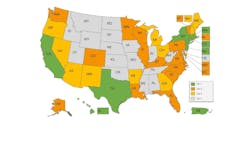California, Hawaii, New Jersey, New York, Connecticut, Massachusetts and Texas score as the top states for microgrid policy activity, with Puerto Rico also listed in the top tier, according to a new report by Think Microgrid.
The state policy assessment marks the first time “any organization has looked specifically at the policy landscape for microgrids where it matters the most — at the state level,” said Cameron Brooks, executive director of Think Microgrid, a coalition affiliated with Microgrid Knowledge that educates regulatory and political leaders about the technology.
Together, the top microgrid friendly states, along with Puerto Rico, represent more than one-third of the electricity market in the US and have significant microgrid activity, Brooks said.
The top tier states have taken policy action to advance microgrid markets. Hawaii and California, as well as Washington DC (a second tier state) have developed microgrid tariffs driven by public utility commissions. New Jersey, New York, Connecticut and Massachusetts have created competitive microgrid grant programs. Puerto Rico stands out because it requires microgrid deployment in utility resource planning. And Texas and Florida (a second tier state) have the largest deployments of commercial microgrids, the report said.
The report also shows that numerous states are just beginning to consider the role microgrids can play, said Brooks.
The assessment, which categorizes the states’ efforts into four tiers — with Tier 1 states having the most effective microgrid policies — is based on a look at five issues:
1. Deployment: The report ranked states based on an analysis of the most robust markets that include all forms of microgrids.
2. Policy: States with proactive and comprehensive efforts to establish clear objectives, modernize rules and update regulations scored higher in the ranking.
3. Resilience: The report looked at whether states focus on practical opportunities to deploy microgrids that provide resiliency to customers, communities and critical facilities.
4. Grid services: States received high marks for working on establishing open markets, clear rules and other incentives to encourage investments from both utility ratepayers and private capital.
5. Equity: The report scored states for mechanisms that advance social equity and environmental justice priorities.
“In the past year, what we’ve learned at Think Microgrid is that there is a tremendous amount of enthusiasm about microgrids, in general, but not a lot of understanding about what they are and how they can be deployed,” Brooks said. “But it’s also important to recognize that policy ‘beauty’ is in the eye of the beholder. Just because there is notable activity underway, it doesn’t necessarily mean that the policies established will support all forms of microgrids.”
From a technical and operational point of view, a single customer installing a microgrid in a commercial setting is very different from a multicustomer deployment, and the policy issues are very different, he added.
The report provides a framework for analyzing several issues that add value to microgrids — their ability to provide resilience, environmental equity and clean energy. Policy reform is also analyzed, said Brooks.
Tier 2 and 3 states
The top Tier 2 states — those that feature advancements in a few policy areas — are Illinois, Colorado, North Carolina, Virginia, South Carolina, Maryland, Pennsylvania, Alaska, Rhode Island, Vermont, Washington, Washington DC, Louisiana, Kentucky, Wisconsin and Minnesota.
The Tier 2 states are characterized by high deployment (Florida, North Carolina, Virginia and South Carolina), microgrid grant programs (Colorado, Wisconsin, Minnesota and Maryland), access to grid services (Vermont and Washington) and those offering microgrid feasibility studies (Rhode Island and Kentucky), the report said.
“Generally, each [Tier 2] state stands out for advancement in one or a few evaluation criteria but does not have comprehensive activity in all of the evaluation areas,” said the report.
The states and territories that comprise Think Microgrid’s Tier 3 ranking are Maine, Oregon, Michigan, Ohio, Georgia, Arizona, New Mexico, Arkansas, New Hampshire and Nevada. These states — such as Maine — offer one standout microgrid or resilience policy but have limited other activities. Michigan, Oregon and New Mexico have a patchwork of activity indirectly related to microgrid deployment. And Georgia and Arkansas have high commercial microgrid development but no other activity, the report said.
“The barriers, where they exist, are mostly rooted in policy, not technology.” — Cameron Brooks, Think Microgrid
The standout policies in the top-ranking states include microgrid tariffs established by public utility commissions. Among them is California’s ongoing rulemaking on microgrids (Docket R-19-09-009), which aims to develop microgrid tariffs and drive deployment. In December 2021, California utilities jointly filed a proposal in the program to develop multicustomer and clean energy community microgrids that aim to meet resilience goals for low-income and communities vulnerable to extreme weather.
“The [California] awards will evaluate community equity, resilience and environmental benefits of microgrid projects, with a special priority to projects that can be completed quickly,” said the report.
Hawaii also established a microgrid tariff initiated by the public utility commission (Docket No. 2018-0163). In May 2021, the Hawaii Public Utilities Commission issued a final decision in its first phase of the proceeding and established tariffs. It also ruled out creating a microgrid standby charge.
For New Jersey, the Think Microgrid report focused on the state’s Town Center DER (distributed energy resource) microgrid deployment program facilitated by the Board of Public Utilities (Docket No. QO16100967). The program has paid for feasibility studies for more than three dozen potential microgrid sites in New Jersey. The program, now in its second phase, has awarded grants to towns and municipalities with proposals for projects that increase resilience for community centers or critical facilities, said the report.
Think Microgrid National Microgrid Activity: By Market Size (See full report for small and medium states.)
Microgrid growth
Think Microgrid noted that microgrids are poised for growth, saying that 1,000 projects are under construction or are expected to come online by 2026 in the 10 most active states.
Most states only have a handful of microgrids — for now. But that’s going to change and policymakers need to be prepared, the report said.
“We hope that the assessment provides state and federal officials with a road map for meaningful action,” said Brooks. Some governors have already taken meaningful action by making energy resilience a statewide, cabinet-level priority, Brooks added. And state officials are learning how microgrids can support clean energy goals and electric vehicle deployment, he said.
“The barriers, where they exist, are mostly rooted in policy, not technology,” Brooks said. “What we’ve found is that there is a lot of interest in bringing policymakers together with industry leaders to ensure that new policies are as informed as they can possibly be.”
Learn more about the top states for microgrid policy activity. Read the full Think Microgrid report.









